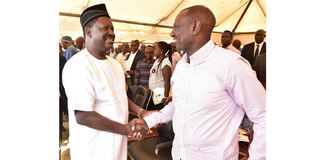Premium
Factors influencing the results of opinion polls

ODM leader Raila Odinga (left) and Deputy President William Ruto.
The Nation-Infotrak poll conducted on May 8 and 9 differs markedly from a latest one by Tifa Research which collected data from April 22 to 26.
Whereas the Nation poll has Deputy President William Ruto and ODM leader Raila Odinga tied at 42 per cent of the national poll each, Tifa, had the DP ahead 39 percent to 32.
The dates the data was collected will always have a bearing on the outcome in a fluid political situation, but unless there were very major shifts and realignments in the intervening period, even a fortnight between two polls cannot account for such variations.
Other factors which influence the outcome of an opinion poll are methodology and sampling.
The Tifa and Nation polls were largely similar. Both collected data from the 47 counties, targeting registered voters over 18 and employing computer-assisted phone interviews.
The Nation poll recorded 2,400 respondents while Tifa had 2,033.
In both polls, distribution of the nationally representative survey sample across the counties was proportionally allocated in regard to number of registered voters, age groups and gender.
One difference, which should not have significantly affected the outcomes, was that while the Nation poll was based on the former provincial administration boundaries of Coast, North Eastern, Eastern, Central, Rift Valley, Western and Nyanza; the Tifa one broke up some larger provinces into sub-regions that reflect the ethnic diversity.
Thus the giant Rift Valley was split into Central, South Rift and Northern; Eastern was hived out into Lower Easter and Meru and Tharaka Nithi counties were placed under Mt Kenya.
From past experience, the areas selected for data collection within every region have a major influence on the outcome if existing political leanings are not taken into account.
There may be need for closer look at the sampling frames for both polls to determine if any biases were introduced that may explain the variation.
A trend analysis from the Nation against previous Infotrack polls shows that in November 2021, Dr Ruto was comfortably ahead of Mr Odinga at 34 to 25 per cent, a nine-point gap.
A month later, it was a virtual dead heat, with Mr Odinga edging narrowly ahead at 33 per cent to 32, and again the same gap in March 2022 at 36 per cent to 35.
Then came the Nation poll this month where the two were tied at 42 per cent.
All other declared presidential candidates, including Musalia Mudavadi, Kalonzo Musyoka and Gideon Moi before they pulled out to join either of the Ruto or Odinga coalitions, had negligible support.
The Tifa polls on over the same period had Dr Ruto ahead at a virtually unchanged 38 per cent, in November 2021, same percentage in February 2022, and 39 per cent in April 2022.
Over the same period, Mr Odinga trailed in November 2021 with 23 per cent, reducing the gap by four points in February when he recorded 27 per cent, and again closing in at the last poll in April with 32 per cent.





